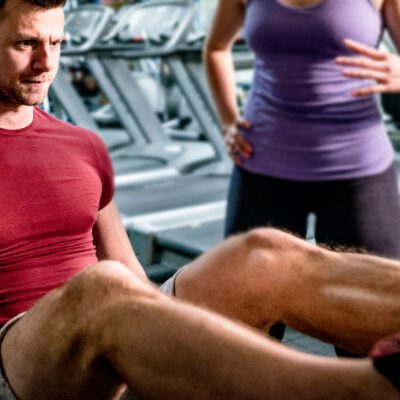Just because an exercise seems to have been around forever and has been performed by some of the old-school legends, doesn’t necessarily mean it’s a perfect fit for your overall routine.
For some people, certain exercises aren’t worth the risk of injury or the minimal amount of gains you may get out of performing them. At the same time, there’s no reason you couldn’t be making gains from a wide list of quality alternatives. Getting stronger—and staying healthier—is the way to go toward adding muscle and strength.
We selected five exercises that although may work with great success for some people, may not necessarily be the best choice for everyone. This is not to say that these five exercises are automatic toss-outs for everyone—when it comes to fitness, there are always exceptions. But if you’re performing two or more of these moves on this list regularly, it’s possible that in order to stay healthier in the long term, it may be time to ditch these and try these exercise alternatives.
Replace this Move: Hip Abduction Machine
In theory, isolating the glutes’ smaller muscles with abduction is a good idea. The glute medius and mini play an essential role in hip internal and external rotation, hip mobility, single-leg balance, and knee stability.
But sitting with your knees and hips flexed with your thighs saying yes/no looks silly (not just for men but women too) but provides minimal benefit IMO to those muscles. They work best when standing and are used with other hip and thigh muscles.
Swap with these: Lateral Mini Band Walk
When you do this for sets of 15-20 reps, you feel the true meaning of the glute medius and mini. When men have trouble feeling their glutes, the lateral walk will light them up without spreading their thighs apart.
Tip: Ensure you keep your toes pointed forward and take smaller steps.
Lateral Stepup
As mentioned, training the glute med and mini is best performed standing up and in concert with other muscles. The lateral stepup trains all three glute muscles, adductors, quads, and hamstrings for a better glute-building experience. This exercise trains the proper functions of the hip adductors, knee stability, and single-leg balance.
Tip: There is a tendency with stepups to use the momentum from the non-working leg. Don’t do that. Focus on pushing the working foot into the bench with the back leg just coming long for the ride.
Replace this Move: Behind the Neck Overhead Press
Unless you’re an Olympic lifter slinging heavy weights overhead, ignore this. All strength exercises, whether you know it or not, have a risk-to-reward ratio. If the risks outweigh the rewards and there is a viable alternative, then it’s not worth doing it.
IMO behind neck presses fall into this category. If you repeatedly put the shoulder joint in this position, your shoulder will get angry. Ask any baseball pitcher how their pitching shoulder feels at the end of the season.
Combine this with the mobility demands, the position it puts the neck in, and using less load because it’s not the strongest position for the shoulder; it is a bad exercise for most men.
Swap with These: Wide Dumbbell Shoulder Press
One of the reasons to use the behind-the-neck press is to focus on the deltoids and not the triceps. Because the wider the grip, the less triceps involvement and more delts. The dumbbell’s shoulder press targets the delts more without putting your neck in a comprised position, and you’ll strengthen imbalances between sides for better muscle development.
Tip: Doing this exercise while sitting down provides more stability so you can focus on the delts more. Not lowering the elbows to below the shoulders will keep better tension on the delts.
Barbell Push Press
The standard barbell overhead press is OK, but how often do you lift anything overhead without using your legs? Using a quarter squat allows you to train more muscle and the ability to press more weight. Last time I checked, using more weight is the biggest driver for muscle growth.
Tip: Using a slight pause in the overhead position and lowering the barbell with control will give your delts all the action they deserve.
Replace this Move: Dumbbell Bench Chest Flye
Just hear me out on this one because dumbbell fly’s are an exercise to isolate the chest and are performed by probably most of the old-school bodybuilders on the planet. This exercise takes you through an extensive range of motion for better muscle stretch and gains. So why is this not the best exercise for men?
Well, it’s not, but there are better options.
Remember, the shoulder joint doesn’t like repeatedly being in an abduction externally rotated position. This is the position for the standard dumbbell flye. Plus, to get a bigger ROM, the anterior shoulder glides forward to put the shoulder at further risk. Let’s not forget that some men go far too heavy and turn it in a press, not a fly. And guess what this causes? If you thought shoulder pain, you get a gold star.
Swap with These: Cable Machine Flye
Here you will get the isolation benefits of the chest flye, and the cable machine gives you constant tension throughout the ROM for better muscle-building gains. Plus, this tension makes you more of your body’s position to avoid putting your shoulders at further risk.
The biggest mistake many lifters make with the dumbbell chest flye is going too heavy, putting their shoulders at risk, and using more triceps and less chest. This is less likely to happen with the constant tension of the cables.
Tip: The chest is a fan-like muscle with fibers running in all directions. And with the cable machine, you will change the angle of the fly for better chest-building benefits.
Dumbbell Floor Chest Flye
If you’re hellbent on performing dumbbell chest flies because you disagree with me (and that’s fine), give the floor variation a shot. You will limit external shoulder rotation, which gets some lifters into trouble, and you work in a shortened range of motion for constant tension on the chest muscles. Lying on the floor also limits body English and the temptation to go too heavy.
Tip: Keeping the elbow bet to almost 90 degrees and resting your entire triceps on the floor will help you get the best out of this chest fly variation.
Replace this Move: Full Situps
There’s been much debate on the merit of this exercise and whether flexion is good or bad for the spine. But here is something most exercise professionals will agree on, there are far better options for training ‘your abs’ than the sit-up. Remember the risk/reward ratio mentioned previously?
This holds for the sit-up. The constant flexion and extension of the lower back will likely piss off your lower back because your lower back isn’t a fan of either of those things. Combine this with the fact that most people are sitting more, with their back in flexion; adding to this puts most men at more risk than reward.
Can you get away with doing sit-ups because you have always done them? Why put your lower back at further risk than you have to? The lower back can go bang at any moment; when and if it does, you may have wished to heed this advice.
Swap with These: Rollbacks
Technically, this looks like a sit-up after ripping them apart. But with the rollbacks, you don’t get the flexion and extension on the lower back like the regular sit-up, and focusing on the eccentric contraction will have you feeling your ‘abs’ more. When you slow down the negative muscle contraction, you will get stronger due to more time under tension.
Tip: Have your head tilted forward, hands behind the head, and elbows pointed forward the entire time. The slower, the lower, the better.
Weighted Stability Ball Crunch
The weighted stability ball crunch trains the abs safely without too much lower back involvement. Doing this crunch on a stability ball increases the activation of your core stabilizers, which provides greater resistance to injury. (1) Adding weight to this crunch variation is the cherry on top.
Tip: Holding the weight with arms extended over your chest makes this move slightly more challenging and trains the serratus anterior for better shoulder health.
Replace this Move: High Box Jumps
A healthy ego is excellent, but a raging testosterone ego in the gym is not great. High box jumps are one of those to see how far I can jump without putting myself in a hospital type of exercise. Just because you can doesn’t mean you should.
High box jumps don’t tell you how far you can jump, but it shows you your hip mobility is top-notch. Let’s not overlook the risk/reward factor. You could seriously hurt yourself if you miss the jump. Is that worth all of the bragging rights? Leave the circus tricks to the professionals to continue getting gains safely.
Swap with These: Regular Box Jumps
Box jumps are more about how quickly and powerfully you can jump and how your body absorbs force and less about how high you can jump. Jumping higher is great, but are you training explosiveness or just hip mobility? Keeping the box height at a reasonable height and only going higher when the beginning and end of your box jumps are the same works best.
Tip: Box jumps are a high-impact, high-intensity exercise, and when you start to lose power and explosiveness, you’re missing the point. Stop when you lose power because box jumps are not an AMRAP exercise.
Depth Jumps
Instead of jumping high, have you considered dropping from a greater height and jumping again? Depth jumps improve vertical height and landing mechanics better than high box jumps. Here, you step off the box, absorb force, and react quickly by going straight into a vertical jump.
Tip: If you have never tried this exercise, start on the lower box height, around 18 inches. Thinking that you are landing on hot coals will encourage you to react faster when you land.





